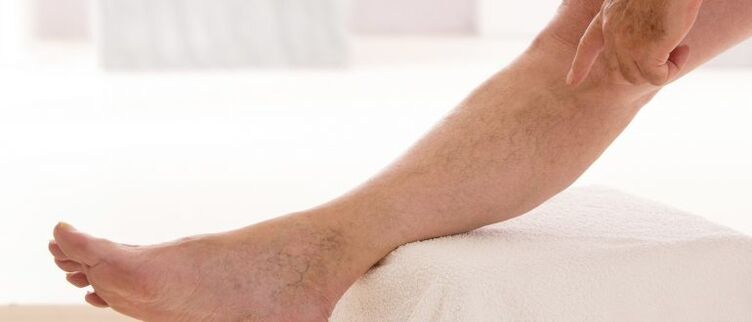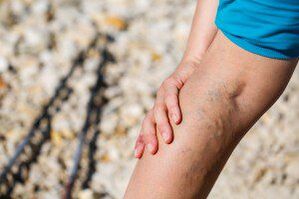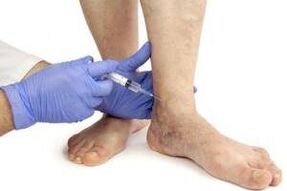
There is no need to remember the predominance of vascular diseases.In the summer season, whenever you go out, you can notice the blue net on the women and men's calves.Not everyone knows for sure how dangerous this pathology is.
What are the varicose veins
What are varicose veins?This is a disease where peripheral arteries become swollen.They become torture, bad and elongated over the surface of the skin.
Normal blood flow is interrupted and pressure occurs.
When it reaches the maximum concentration, the walls of the blood vessels extend.
The legs become blue due to the large number of elongated vessels and venous network.
Risk factors
Factors provoking the appearance of varicose veins include:
- taking hormonal medicines, pregnancy;
- Impact of additional pounds, overweight;
- hereditary factor;
- Work at high temperatures, constantly sitting or standing.
You need to constantly monitor your lifestyle.Avoid overloading your feet or doing a lot of physical activity.
Prevent the first signs as soon as possible.

Causes
There are two conditional subgroups: primary and secondary causes of the disease.
Elementary:
- hard physical work;
- sedentary lifestyle;
- weight gain;
- hereditary factor;
- Genetic location.
Secondary:
- stress and experiences;
- pressure in the area of the arterial blood branch;
- More weighty physical training;
- very tight clothes, tight shoes;
- Violation of the endocrine system.
Varicose vein development mechanism
It all begins with mild manifestations, it seems that simple fatigue acts on the joints.At the end of the working day, swelling, pain in calves, convulsions are periodically concerned.
Soon, manifestations are observed by the visible free eye.First, a light vascular mesh manifests on the foot, and then nodular.
The mechanism of developing the disease should stop as soon as the first pain is felt.
PHASE
There are 6 phases of varicose veins.They develop quickly quickly.If you do not treat the disease in the first stage, you can quickly find yourself at the operating table.
Scale - 0. A person begins to feel the whole range of sensations inherent in the disease, but the examination does not indicate a positive result.
Scale - 1. Symptoms Progress and a venous mesh appear in the leg.
Scale - 2. From this stage, a manifestation of typical varicose veins begins.The connections are hurting after a load or a long stagnation.The arteries swell, the joints appear.
Grade - 3. The rest is added edema, which is more pronounced in the evening.
Grade - 4. Trophic changes are developing.The limbs acquire a sore appearance, skin color appears and wounds appear.
Scale - 5. The set of all manifestations and a healed ulcer.
Grade - 6. Trophic ulcer continues to develop actively.

Types of vascular disease
This varicose vein classification is divided based on the types of the affected body.
There are only 4 types of them, namely:
- Reticular varicose veins.There are no complications at this stage, only small capillaries are affected.Therapy quickly eliminates this defect;
- segmental.The initial phase of varicose veins is considered.The arteries of the branch are allocated;
- The trunk is called varicose veins when participating a large and small subcutaneous artery.Channels increase, as the symptom is insufficient circulation;
- Perforant.The connecting veins and surface vessels under the skin expand.
Listed types of varicose veins are characteristic of the different stages of development and manifestation of venous deformation.
Than the disease is dangerous in the absence of time therapy
With this pathology, it is very important to turn to specialists in a timely manner.Every phase quickly goes to a new one.
By gaining speed, varicose veins can go through more serious problems.
- Thrombosis.When the blood thickens, it blocks the vessels.Clothes are formed.The legs hurt and swell.
- Teleangiectasia.Harmony that aesthetically does not decorate the legs.Vascular nets appear.And also relate to convulsions and swelling.
- Thrombophlebitis.A complex disease with characteristic symptoms.Dark skin, redness, blockage of blood vessels, blood clots.
- Trophilic ulcer.This is a consequence of a severe shape of varicose veins.Blood circulation is broken, open wounds appear, ulcers appear.
- Bleeding.The arteries are so covered and inflated the skin to become thinner and break down over time.Hemorrhage can be internal and external.
Troubleshooting
Often, the symptoms are bright and clearly expressed.
Do not make a diagnosis yourself, it is best to undergo an examination by specialists.
Patient complaints
Initially, varicose veins are not shown on their own.
The most common complaints can be swelling, heel fatigue and convulsions at night.

Clinical inspection
The appearance of the lower extremities will indicate a diagnosis.The legs are swollen, with a light or pronounced vascular mesh.
In the last stages, ulcers are possible.
Instrumental techniques
Your doctor should refer you to ultrasound diagnosis.This method is very informative.It will indicate the condition of the vessels, the blood flow, the patent, the presence of blood clots, etc.
Laboratory techniques
With the help of tests, pathology cannot be detected, but it will definitely help to learn about the blood condition.
An excess number of white blood cells indicates that an inflammatory process is occurring in the body.
Which specialists should you contact?
If warning signs and symptoms are detected, specialists will immediately make a diagnosis.
What kind of doctor is needed?
First of all, a phlebologist.The specialization of the doctor is specifically aimed at the study of vein pathologies.
Therapist.The doctor will definitely prescribe tests and, based on the results, will refer you to a specific specialist who will significantly save your time.
Vascular surgeon.Its task is simple: to determine if the condition of the veins and blood vessels has changed due to the development of the disease.As a result, describe treatment or prevention.
Angiologist.Specialists in this area prefer conservative intervention.This only helps to eliminate subsequent growth of symptoms.Therefore, in severe stages, a visit to this doctor would be inappropriate.
Symptoms of pathology
To avoid running The disease to incurable complications, it is necessary to know all the symptoms that may occur during the development of this disease.
The disease to incurable complications, it is necessary to know all the symptoms that may occur during the development of this disease.
Key features:
- the appearance of warmth;
- pain and weight;
- swelling and cramping in the evening;
- The venous network is brighter than usual;
- Seals on the skin.
Secondary signs:
- External changes cover only the fosos area below the knee and the back surface of the foot;
- The affected tissues are palpable;
- swelling of soft tissues and legs;
- pigmentation and obesity of the skin;
- Trophic ulcers.
There are also severe symptoms of varicose veins that require immediate hospitalization: bleeding, joint rupture.
Therapy
Target treatment for varicose veins depends on its progress.
Conservative methods can be used by patients who immediately seek medical help.
Treatment
After passing a medical diagnosis, the doctor prescribes a course of medication needed for the case.
After the course of treatment, the patient should be diagnosed again to make sure there is no need to continue treatment.
In other cases, the drug is taken repeatedly.
The use of compression materials
A phlebologist individually chooses special interiors, which restores without surgery.
Diet
The patient should use foods to strengthen vascular walls that prevent blood clotting and the appearance of blood clots.They contain the main ingredient - gambling.
For example: seeds without seeds, garlic, cherry, lemon.
Exercise therapy
Exercising with this disease is very important.
Useful loads activate blood circulation and its flow to the lower extremities.

Physiotherapy
One of the methods of treating varicose veins is physiotherapy.The procedures are selected and prescribed only by a physician based on the individual course of the disease.
It can be a massage or laser method.
Hirudotherapy
This procedure relaxes the muscles, dilutes blood, normalizes blood pressure, restores lymph flow.
Surgery
Surgical measures are used when the patient returned late for help.
Key methods of functioning: phlebectomy, short stripping, endoscopic vein dissection.
Preventing for varicose veins
Preventive methods of the disease are very important especially at the initial stage of development.
Try to walk more on your feet, don't wear tight shoes and clothes.Do not get involved in campaigns in a bath or sauna.
After a working day, you can do simple exercises that contribute to relaxation.
Gymnastics
The light classes chosen by a specialist will help activate the blood circulation in the legs.
There are complexes that can be performed not only at home but also in working conditions.
People therapy
Sometimes popular grandmother treatment methods are no less effective.
Here are some of them:
- Horse chestnut tincture.There are three treatment courses, each of which goes as follows: within 7 days before meals, drink the solvent along one tablespoon.Once we take a break for 14 days, and then continue.For production, it is necessary to get 50 grams of plant flowers, 0.5 l of alcohol.We fill the chestnut and insist for two weeks.
- To strengthen blood vessels, drink fresh juices from fruits and vegetables daily.Regular saturation of the body with vitamins will prevent the development of the disease.
Which is harmful with varicose veins
The disease described above does not like heat and large energy loads.You can't jump, run, engage in a routine and step.
Bar fans will also need to push the lesson in order to exclude the load on the lower extremities.


















